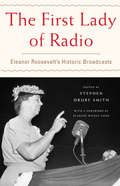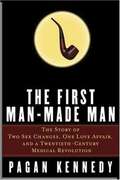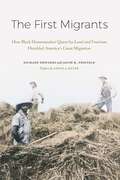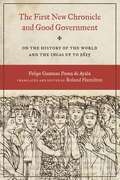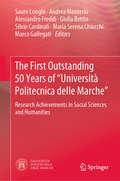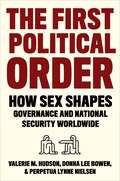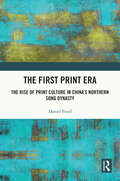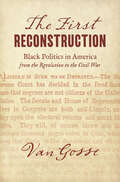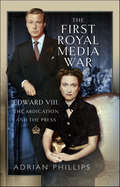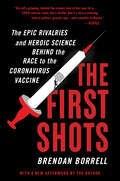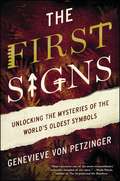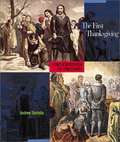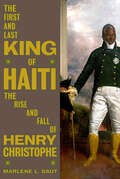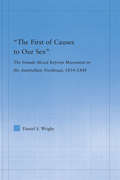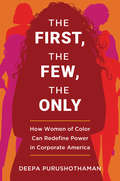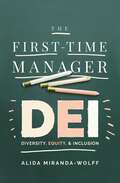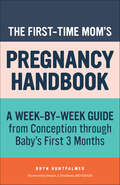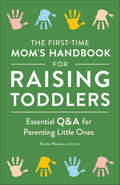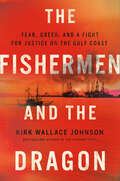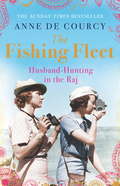- Table View
- List View
The First Labour Party 1906-1914 (Routledge Library Editions: The Labour Movement #4)
by K. D. BrownFirst published in 1985. The essays in this book pull together the diverse strands of research to give a comprehensive picture of the Labour Party, which strived to carve out for itself a niche within an existing political framework. The first part of the book examines the composition, the national, local and regional organisation of the party, and its relations with the working classes, the TUC and the Liberals. In the second part the contributors discuss the party’s stand on the main political issues of the day: education, the suffragettes, Ireland and other major areas of concern in the political arena at the beginning of the century.
The First Lady of Radio
by Blanche Wiesen Cook Stephen Drury SmithOn the afternoon of December 7, 1941, as a stunned nation gathered around the radio to hear the latest about Pearl Harbor, Eleanor Roosevelt was preparing for her weekly Sunday evening national radio program. At 6:45pm, listeners to the NBC Blue network heard the First Lady's calm, measured voice explain that the president was conferring with his top advisors to address the crisis. It was a remarkable broadcast. With America on the verge of war, the nation heard first not from their president, but from his wife.Eleanor Roosevelt's groundbreaking career as a professional radio broadcaster is almost entirely forgotten. As First Lady, she hosted a series of prime time programs that revolutionized how Americans related to their chief executive and his family. Now, The First Lady of Radio rescues these broadcasts from the archives, presenting a carefully curated sampling of transcripts of Roosevelt's most famous and influential radio shows, edited and set into context by award-winning author and radio producer Stephen Drury Smith. With a foreword by Roosevelt's famed biographer, historian Blanche Wiesen Cook, The First Lady of Radio is both a historical treasure and a fascinating window onto the power and the influence of a pioneering First Lady.
The First Man-Made Man: The Story of Two Sex Changes, One Love Affair, and a Twentieth-Century Medical Revolution, First Edition
by Pagan KennedyIn the 1920s when Laura Dillon felt like a man trapped in a woman's body, there were no words to describe her condition; transsexuals had yet to enter common usage. And there was no known solution to being stuck between the sexes. Laura Dillon did all she could on her own: she cut her hair, dressed in men's clothing, bound her breasts with a belt. But in a desperate bid to feel comfortable in her own skin, she experimented with breakthrough technologies that ultimately transformed the human body and revolutionized medicine. From upper-class orphan girl to Oxford lesbian, from post-surgery romance with Roberta Cowell (an early male-to-female) to self-imposed exile in India, Michael Dillon's incredible story reveals the struggles of early transsexuals and challenges conventional notions of what gender really means.
The First Maya Civilization: Ritual and Power Before the Classic Period
by Francisco Estrada-BelliWhen the Maya kings of Tikal dedicated their first carved monuments in the third century A.D., inaugurating the Classic period of Maya history that lasted for six centuries and saw the rise of such famous cities as Palenque, Copan and Yaxchilan, Maya civilization was already nearly a millennium old. Its first cities, such as Nakbe and El Mirador, had some of the largest temples ever raised in Prehispanic America, while others such as Cival showed even earlier evidence of complex rituals. The reality of this Preclassic Maya civilization has been documented by scholars over the past three decades: what had been seen as an age of simple village farming, belatedly responding to the stimulus of more advanced peoples in highland Mesoamerica, is now know to have been the period when the Maya made themselves into one of the New World's most innovative societies. This book discusses the most recent advances in our knowledge of the Preclassic Maya and the emergence of their rainforest civilization, with new data on settlement, political organization, architecture, iconography and epigraphy supporting a contemporary theoretical perspective that challenges prior assumptions.
The First Migrants: How Black Homesteaders' Quest for Land and Freedom Heralded America's Great Migration
by Richard Edwards Jacob K. FriefeldThe First Migrants recounts the largely unknown story of Black people who migrated from the South to the Great Plains between 1877 and 1920 in search of land and freedom. They exercised their rights under the Homestead Act to gain title to 650,000 acres, settling in all of the Great Plains states. Some created Black homesteader communities such as Nicodemus, Kansas, and DeWitty, Nebraska, while others, including George Washington Carver and Oscar Micheaux, homesteaded alone. All sought a place where they could rise by their own talents and toil, unencumbered by Black codes, repression, and violence. In the words of one Nicodemus descendant, they found &“a place they could experience real freedom,&” though in a racist society that freedom could never be complete. Their quest foreshadowed the epic movement of Black people out of the South known as the Great Migration. In this first account of the full scope of Black homesteading in the Great Plains, Richard Edwards and Jacob K. Friefeld weave together two distinct strands: the narrative histories of the six most important Black homesteader communities and the several themes that characterize homesteaders&’ shared experiences. Using homestead records, diaries and letters, interviews with homesteaders&’ descendants, and other sources, Edwards and Friefeld illuminate the homesteaders&’ fierce determination to find freedom—and their greatest achievements and struggles for full equality.
The First New Chronicle and Good Government: On the History of the World and the Incas up to 1615
by Roland HamiltonOne of the most fascinating books on pre-Columbian and early colonial Peru was written by a Peruvian Indian named Felipe Guaman Poma de Ayala. This book, The First New Chronicle and Good Government, covers pre-Inca times, various aspects of Inca culture, the Spanish conquest, and colonial times up to around 1615 when the manuscript was finished. Now housed in the Royal Library, Copenhagen, Denmark, and viewable online at www. kb. dk/permalink/2006/poma/info/en/frontpage. htm, the original manuscript has 1,189 pages accompanied by 398 full-page drawings that constitute the most accurate graphic depiction of Inca and colonial Peruvian material culture ever done. Working from the original manuscript and consulting with fellow Quechua- and Spanish-language experts, Roland Hamilton here provides the most complete and authoritative English translation of approximately the first third of The First New Chronicle and Good Government. The sections included in this volume (pages 1-369 of the manuscript) cover the history of Peru from the earliest times and the lives of each of the Inca rulers and their wives, as well as a wealth of information about ordinances, age grades, the calendar, idols, sorcerers, burials, punishments, jails, songs, palaces, roads, storage houses, and government officials. One hundred forty-six of Guaman Poma's detailed illustrations amplify the text.
The First Outstanding 50 Years of “Università Politecnica delle Marche”: Research Achievements in Social Sciences and Humanities
by Sauro Longhi Marco Gallegati Andrea Monteriù Alessandro Freddi Giulia Bettin Silvio Cardinali Maria Serena ChiucchiThe book describes significant multidisciplinary research findings at the Università Politecnica delle Marche and the expected future advances. It addresses some of the most dramatic challenges posed by today’s fast-growing, global society and the changes it has caused, while also discussing solutions to improve the wellbeing of human beings. The book covers the main research achievements made in the social sciences and humanities, and includes chapters that focus on understanding mechanisms that are relevant to all aspects of economic and social interactions among individuals. In line with Giorgio Fuà’s contribution, the interdisciplinary research being pursued at the Faculty of Economics of Università Politecnica delle Marche is aimed at interpreting the process of economic development in all of its facets, both at the national and local level, with a particular focus on profit and non-profit organizations. Various disciplines are covered, from economics to sociology, history, statistics, mathematics, law, accounting, finance and management.
The First Political Order: How Sex Shapes Governance and National Security Worldwide
by Valerie Hudson Donna Lee Bowen Perpetua Lynne NielsenGlobal history records an astonishing variety of forms of social organization. Yet almost universally, males subordinate females. How does the relationship between men and women shape the wider political order? The First Political Order is a groundbreaking demonstration that the persistent and systematic subordination of women underlies all other institutions, with wide-ranging implications for global security and development.Incorporating research findings spanning a variety of social science disciplines and comprehensive empirical data detailing the status of women around the globe, the book shows that female subordination functions almost as a curse upon nations. A society’s choice to subjugate women has significant negative consequences: worse governance, worse conflict, worse stability, worse economic performance, worse food security, worse health, worse demographic problems, worse environmental protection, and worse social progress. Yet despite the pervasive power of social and political structures that subordinate women, history—and the data—reveal possibilities for progress. The First Political Order shows that when steps are taken to reduce the hold of inequitable laws, customs, and practices, outcomes for all improve. It offers a new paradigm for understanding insecurity, instability, autocracy, and violence, explaining what the international community can do now to promote more equitable relations between men and women and, thereby, security and peace. With comprehensive empirical evidence of the wide-ranging harm of subjugating women, it is an important book for security scholars, social scientists, policy makers, historians, and advocates for women worldwide.
The First Print Era: The Rise of Print Culture in China’s Northern Song Dynasty
by Daniel FriedThe First Print Era examines the rise of print culture during China’s Northern Song Dynasty (960–1127). Bringing together often-overlooked primary sources from the period and scholarship on many individual topics in Song print history, the book offers the first extended narrative in English of how print became entrenched as a sustained mode of textual dissemination in China. While discussing technical innovations and the growth of the print industry, the book focuses on how the rise of print affected several indispensable elements of Song intellectual culture: the expansion of the exam system, the canonization of Tang and earlier models, the rise of antiquarianism and connoisseurship, the birth of Neo-Confucianism as a new intellectual force, the growth of a new literati culture and new forms of literary production and critique, and the development of calligraphy as an art form that could be taught, critiqued, and divided into schools. Overall, the book describes a process by which print publication moved from a highly centralized state enterprise, back to expanded elite use, and eventually towards the popular print markets that would create new forms of expression during the Southern Song and Yuan dynasties. This book will be an essential read for students and scholars of Asian studies, Medieval studies, and those with a focus on print history and Chinese studies.
The First Reconstruction: Black Politics in America from the Revolution to the Civil War (The John Hope Franklin Series in African American History and Culture)
by Van GosseIt may be difficult to imagine that a consequential black electoral politics evolved in the United States before the Civil War, for as of 1860, the overwhelming majority of African Americans remained in bondage. Yet free black men, many of them escaped slaves, steadily increased their influence in electoral politics over the course of the early American republic. Despite efforts to disfranchise them, black men voted across much of the North, sometimes in numbers sufficient to swing elections. In this meticulously-researched book, Van Gosse offers a sweeping reappraisal of the formative era of American democracy from the Constitution's ratification through Abraham Lincoln's election, chronicling the rise of an organized, visible black politics focused on the quest for citizenship, the vote, and power within the free states. Full of untold stories and thorough examinations of political battles, this book traces a First Reconstruction of black political activism following emancipation in the North. From Portland, Maine and New Bedford, Massachusetts to Brooklyn and Cleveland, black men operated as voting blocs, denouncing the notion that skin color could define citizenship.
The First Royal Media War: Edward VIII, The Abdication and the Press
by Adrian PhillipsThe abdication crisis of 1936 demolished the wall of silent deference that had protected the British royal family from press comment and intrusion since the days of Queen Victoria. King Edward VIII was a child of the burgeoning age of media and the first celebrity monarch, but the immense personal popularity created by his charm and good looks was not enough to save him when he came into conflict with a government that embodied the conservative ethos of the time. Nor did the support of powerful media barons. In the United States William Randolph Hearst, who inspired Citizen Kane, dreamed of giving Britain an American Queen and maneuvered with Wallis Simpson to place her on the throne. In Britain the Anglo- Canadian newspaper magnate Lord Beaverbrook hoped to use the confrontation between the King and the government to force the prime minister, his bitter enemy Stanley Baldwin, out of power. Edward was blocked from broadcasting his case directly to the public, which was the source of deep resentment to him. The government treated the couple’s media initiatives as declarations of war and was prepared to respond savagely. The British press remained tactfully silent almost until the end of the crisis, but behind the scenes, a cold war was being fought. For the rest of his life, Edward fought to air his grievances against the ill-treatment to which he thought that he had been subjected. He believed that he had been forced to abdicate by a coalition of reactionaries grouped behind the Archbishop of Canterbury. Edward resented bitterly the ostracism to which he and Wallis were subjected by his brother and sister-in-law, King George VI and Queen Elizabeth, especially the refusal to grant his wife royal status. With sometimes farcical results, Edward tried to find authors who put over his side of the story. Beaverbrook supported Edward but tried to bend Edward’s quest to fit his own agenda. The establishment did its utmost to restrain Edward and maintain a discreet silence over the crisis, but gradually members of the royal court abandoned reticence and fought back. The abdication challenged the British monarchy as an institution. A large part of the legacy is today’s no-holds-barred media environment where the royal family's issues are fought in a ruthless glare of worldwide attention.
The First Shots: The Epic Rivalries and Heroic Science Behind the Race to the Coronavirus Vaccine
by Brendan BorrellThe full inside story of the high-stakes, global race for the lifesaving vaccine to end the pandemic Heroic science. Chaotic politics. Billionaire entrepreneurs. Award-winning journalist Brendan Borrell brings the defining story of our times alive through compulsively readable, first-time reporting on the players leading the fight against a vicious virus. The First Shots, soon to be the subject of an HBO limited series with superstar director and producer Adam McKay (Succession, Vice, The Big Short), draws on exclusive, high-level access to weave together the intense vaccine-race conflicts among hard-driving, heroic scientists and the epic rivalries among Washington power players that shaped 18 months of fear, resolve, and triumph. From infectious disease expert Michael Callahan, an American doctor secretly on the ground in Wuhan in January 2020 to gauge the terrifying ravages of Disease X; to Robert (Dr. Bob) Kadlec, one of Operation Warp Speed&’s architects, whose audacious plans for the American people run straight into the buzz saw of the Trump White House factions; to Stéphane Bancel of upstart Moderna Therapeutics going toe-to-toe with pharma behemoth Pfizer, The First Shots lays bare, in a way we have not seen, the full stunning story behind the medical science &“moon shot&” of our lifetimes.
The First Signs: Unlocking the Mysteries of the World's Oldest Symbols
by Genevieve von Petzinger“If you love mysteries, you’ll love this book. Genevieve von Petzinger acts as guide and sleuth in this fascinating, accessible, and fast-paced exploration of Ice Age artists and the evocative cave paintings they left behind” (Virginia Morell, author of Animal Wise and Ancestral Passions).In an adventure worthy of Indiana Jones, archeologist von Petzinger explores the little-known geometric cave art of our ancient ancestors—perhaps the first form of human written communication and a key to unlocking some of the mysteries of our ancient past. These &“remarkable&” (Jean Auel, author of the bestselling Earth&’s Children series) findings &“may represent one of the most extraordinary scientific insights of our time&” (Wade Davis, author of The Serpent and the Rainbow). Join von Petzinger as she travels throughout Europe and attempts to crack the code of these strange symbols, which persisted virtually unchanged for some 30,000 years. Clearly meaningful to their creators, these geometric signs are one of the first indicators of our human ancestors&’ intelligence and capacity for symbolic meaning and language—glimpses across millennia of an ancient consciousness linked to our own. Part travel journal, part popular science, and part personal narrative, this groundbreaking investigation explores what makes us human, how we evolved as a species, and how this cave art laid the foundation for so much of the technology that we enjoy today.
The First Thanksgiving (Cornerstones of Freedom, 2nd Series)
by Andrew SantellaDiscusses the history of New Plymouth Colony in Massachusetts, the relationship between the colonists and the native Wampanoag people, and the harvest festival which would later become Thanksgiving Day.
The First and Last King of Haiti: The Rise and Fall of Henry Christophe
by Marlene L. DautThe essential biography of the controversial rebel, traitor, and only king of Haiti. Henry Christophe is one of the most richly complex figures in the history of the Americas, and was, in his time, popular and famous the world over: in The First and Last King of Haiti, a brilliant, award-winning Yale scholar unravels the still controversial enigma that he was.Slave, revolutionary, traitor, king, and suicide, Henry Christophe was, in his time, popular and famous the world over. Born in 1767 to an enslaved mother on the Caribbean island of Grenada, Christophe first fought to overthrow the British in North America, before helping his fellow enslaved Africans in Saint-Domingue, as Haiti was then called, to gain their freedom from France. Yet in an incredible twist of fate, Christophe ended up fighting with Napoleon&’s forces against the very enslaved men and women he had once fought alongside. Later, reuniting with those he had betrayed, he offered to lead them and made himself their king. But it all came to a sudden and tragic end when Christophe—after nine years of his rule as King Henry I—shot himself in the heart, some say with a silver bullet.Why did Christophe turn his back on Toussaint Louverture and the very revolution with which his name is so indelibly associated? How did it come to pass that Christophe found himself accused of participating in the plot to assassinate Haiti&’s first ruler, Dessalines? What caused Haiti to eventually split into two countries, one ruled by Christophe in the north, who made himself king, the other led by President Pétion in the south? The First and Last King of Haiti is a riveting story of not only geopolitical clashes on a grand scale but also of friendship and loyalty, treachery and betrayal, heroism and strife in an era of revolutionary upheaval.
The First of Causes to Our Sex: The Female Moral Reform Movement in the Antebellum Northeast, 1834-1848 (Studies in American Popular History and Culture)
by Daniel S. WrightThe First of Causes to Our Sex is a study of the first movement in the United States for social change by and for women. Female moral reform in the 1830s and '40s was a campaign to abolish sexual vice and the sexual double standard, and to promote sexual abstinence among the young as they entered the marriage market. The movement has earned a place in U.S. women's history, but most research has focused on it as an urban phenomenon, and sought its significance in relation to the cause of women's rights or to the regulation of prostitution. This study explores the appeal of moral reform to rural women, who were the vast majority of its constituency, and sees it as a response to seminal changes in family formation and family size in the context of an increasingly market-oriented and mobile society. It was led by Yankee women who were fired by Second Great Awakening revivals and supported by reformist clergy.
The First, the Few, the Only: How Women of Color Can Redefine Power in Corporate America
by Deepa PurushothamanA deeply personal call to action for women of color to find power from within and to join together in community, advocating for a new corporate environment where we all belong—and are accepted—on our own terms.Women of color comprise one of the fastest-growing segments in the corporate workforce, yet often we are underrepresented—among the first, few, or only ones in a department or company. For too long, corporate structures, social zeitgeist, and cultural conditioning have left us feeling exhausted and downtrodden, believing that in order to “fit in” and be successful, we must hide or change who we are.As a former senior partner at a large global services firm, Deepa Purushothaman experienced these feelings of isolation and burnout. She met with hundreds of other women of color across industries and cultural backgrounds, eager to hear about their unique and shared experiences. In doing so, she has come to understand our collective setbacks—and the path forward in achieving our goals. Business must evolve—and women of color have the potential to lead that transformation. We must begin by pushing back against toxic messaging—including the things we tell ourselves—while embracing the valuable cultural viewpoints and experiences that give us unique perspectives at work. By fully realizing our own strengths, we can build collective power and use it to confront microaggressions, outdated norms, and workplace misconceptions; create cultures where belonging is never conditional; and rework corporations to be genuinely inclusive to all.The First, the Few, the Only is a road map for us to make a profound impact within and outside our organizations while ensuring that our words are heard, our lived experiences are respected, and our contributions are finally valued.
The First-Time Manager: Diversity, Equity, and Inclusion
by Alida Miranda-WolffThe essential resource for new managers who want to foster a safe, inclusive, and productive space for their teams.Being an inclusive manager boils down to finding ways to balance power and love day-to-day. When do we prioritize the needs of an individual employee over that of the whole team? When do we hold firm that what the team needs is more important than what the individual wants? How do we ensure that we uphold one person&’s boundaries without compromising another&’s? How do we live up to the promises we make to ourselves and to each other, all while driving results and hitting our earnings targets?Alida Miranda-Wolff has worked with hundreds of organizations to help them create cultures of belonging and successful DEI initiatives, which means she knows the common pitfalls to avoid and action items required to make DEI work. In this practical guide, she shares both the mindset and actions required for new managers to build inclusive teams. This one-of-a-kind guide will: Help you define your inclusive management style.Provide practical guidance on how to create a healthy culture on your teams through equitable practices.Teach you the basics of inclusive language.Offer guidance on how to give and receive feedback.Help you manage identity-based conflict.
The First-Time Mom's Pregnancy Handbook: A Week-by-Week Guide from Conception through Baby's First 3 Months (First-Time Mom's Handbook)
by Bryn HuntpalmerThe essential pregnancy guide for the modern womanThe vast amount of information in encyclopedia-sized pregnancy books for first-time moms can be overwhelming and anxiety inducing. The First-Time Mom's Pregnancy Handbook is different. Including need-to-know advice relevant to the majority of women and pregnancies. This week-by-week guide will prepare and empower you during pregnancy and beyond.In the world of pregnancy books for first-time moms, this one is a go-to. With weekly goals you can focus on, including nutrition and milestone trackers, questions for OB-GYNs or midwifes, and tips on caring for your newborn, you'll be more than prepared for the big day.This standout among pregnancy books for first-time moms delivers:40+ weekly milestones—From conception through the first few months of baby's life, set and accomplish goals based on your weekly priorities and needs.Baby and mom stats—Of all pregnancy books for first-time moms, this one offers a week-by-week rundown of your baby's development, symptoms you may be experiencing, major appointments, and more.Postpartum prep—Tips for focusing on your emotional health, healing your body after childbirth, taking care of your newborn, and thriving as a new mother.When you're thinking about pregnancy books for first-time moms, think about this one.
The First-Time Mom’s Handbook for Raising Toddlers: Essential Q&A for Parenting Little Ones
by Kristin PleinesQuestions about raising toddlers? You've come to the right place. Congratulations! Your baby is now a toddler. This is an incredibly exciting time, where kids learn and grow by leaps and bounds. But it also comes with a whole new list of questions and challenges—especially if it's your first child. Are they eating right? Are these tantrums normal? Should they be talking more? This supportive guide is full of clear advice for tackling development, behavior, communication, and more, so you can raise a happy, healthy toddler.What sets this toddler parenting book apart:A friendly Q&A format—Feel like you're talking to a knowledgeable friend with topics presented as conversational questions and answers.Easy organization—Each chapter covers a different aspect of toddler wellness, from potty training to self-esteem, so you can easily flip through the pages to find what you need.Tips for tykes on any timeline—Keep using this book as your little one grows! It's designed for the widest possible range of toddlers—from about 18 months to 5 years old.Find pro tips for parenting toddlers with this ultimate book of frequently asked questions.
The Fiscal Dimensions of Adjustment in Low-Income Countries
by Sanjeev Gupta Claire Liuksila Henri Lorie Karim Nashashihi Walter MahlerA strengthened fiscal position is at the core of most economic adjustment programs supported by IMF lending, especially for the poorer countries that draw on the IMF's structural adjustment facilities. This paper reviews developments in 23 countries and evaluates their experience with fiscal and structural adjustment, including their efforts to design social safety nets to cushion the effects of adjustment.
The Fisher Folk of Late Imperial and Modern China: An Historical Anthropology of Boat-and-Shed Living (The Historical Anthropology of Chinese Society Series)
by Xi He David FaureAlthough most studies of rural society in China deal with land villages, in fact very substantial numbers of Chinese people lived by the sea, on the rivers and the lakes. In land villages, mostly given to farming, people lived in permanent houses, whereas on the margins of the waterways many people lived in boats and sheds, and developed their own marked features, often being viewed as pariahs by the rest of Chinese society. This book examines these boat and shed living people. It takes an "historical anthropological" approach, combining research in official records with investigations among surviving boat and shed living people, their oral traditions and their personal records. Besides outlining the special features of the boat and shed living people, the book considers why pressures over time drove many to move to land villages, and how boat and shed living people were gradually marginalised, often losing their fishing rights to those who claimed imperial connections. The book covers the subject from Ming and Qing times up to the present.
The Fishermen and the Dragon: Fear, Greed, and a Fight for Justice on the Gulf Coast
by Kirk Wallace JohnsonA gripping, twisting account of a small town set on fire by hatred, xenophobia, and ecological disaster—a story that weaves together corporate malfeasance, a battle over shrinking natural resources, a turning point in the modern white supremacist movement, and one woman&’s relentless battle for environmental justice.By the late 1970s, the fishermen of the Texas Gulf Coast were struggling. The bays that had sustained generations of shrimpers and crabbers before them were being poisoned by nearby petrochemical plants, oil spills, pesticides, and concrete. But as their nets came up light, the white shrimpers could only see one culprit: the small but growing number of newly resettled Vietnamese refugees who had recently started fishing. Turf was claimed. Guns were flashed. Threats were made. After a white crabber was killed by a young Vietnamese refugee in self-defense, the situation became a tinderbox primed to explode, and the Grand Dragon of the Texas Knights of the Ku Klux Klan saw an opportunity to stoke the fishermen&’s rage and prejudices. At a massive Klan rally near Galveston Bay one night in 1981, he strode over to an old boat graffitied with the words U.S.S. VIET CONG, torch in hand, and issued a ninety-day deadline for the refugees to leave or else &“it&’s going to be a helluva lot more violent than Vietnam!&” The white fishermen roared as the boat burned, convinced that if they could drive these newcomers from the coast, everything would return to normal. A shocking campaign of violence ensued, marked by burning crosses, conspiracy theories, death threats, torched boats, and heavily armed Klansmen patrolling Galveston Bay. The Vietnamese were on the brink of fleeing, until a charismatic leader in their community, a highly decorated colonel, convinced them to stand their ground by entrusting their fate with the Constitution. Drawing upon a trove of never-before-published material, including FBI and ATF records, unprecedented access to case files, and scores of firsthand interviews with Klansmen, shrimpers, law enforcement, environmental activists, lawyers, perpetrators and victims, Johnson uncovers secrets and secures confessions to crimes that went unsolved for more than forty years. This explosive investigation of a forgotten story, years in the making, ultimately leads Johnson to the doorstep of the one woman who could see clearly enough to recognize the true threat to the bays—and who now represents the fishermen&’s last hope.
The Fishing Fleet: Husband-Hunting in the Raj
by Anne de CourcyThe adventurous young women who sailed to India during the Raj in search of husbands.From the late 19th century, when the Raj was at its height, many of Britain's best and brightest young men went out to India to work as administrators, soldiers and businessmen. With the advent of steam travel and the opening of the Suez Canal, countless young women, suffering at the lack of eligible men in Britain, followed in their wake. This amorphous band was composed of daughters returning after their English education, girls invited to stay with married sisters or friends, and yet others whose declared or undeclared goal was simply to find a husband. They were known as the Fishing Fleet, and this book is their story, hitherto untold.For these young women, often away from home for the first time, one thing they could be sure of was a rollicking good time. By the early 20th century, a hectic social scene was in place, with dances, parties, amateur theatricals, picnics, tennis tournaments, cinemas and gymkhanas, with perhaps a tiger shoot and a glittering dinner at a raja's palace thrown in. And, with men outnumbering women by roughly four to one, romances were conducted at alarming speed and marriages were frequent. But after the honeymoon, life often changed dramatically: whisked off to a remote outpost with few other Europeans for company, and where constant vigilance was required to guard against disease, they found it a far cry from the social whirlwind of their first arrival.Anne de Courcy's sparkling narrative is enriched by a wealth of first-hand sources - unpublished memoirs, letters and diaries rescued from attics - which bring this forgotten era vividly to life.
The Fishing Fleet: Husband-Hunting in the Raj
by Anne de CourcyThe adventurous young women who sailed to India during the Raj in search of husbands.From the late 19th century, when the Raj was at its height, many of Britain's best and brightest young men went out to India to work as administrators, soldiers and businessmen. With the advent of steam travel and the opening of the Suez Canal, countless young women, suffering at the lack of eligible men in Britain, followed in their wake. This amorphous band was composed of daughters returning after their English education, girls invited to stay with married sisters or friends, and yet others whose declared or undeclared goal was simply to find a husband. They were known as the Fishing Fleet, and this book is their story, hitherto untold.For these young women, often away from home for the first time, one thing they could be sure of was a rollicking good time. By the early 20th century, a hectic social scene was in place, with dances, parties, amateur theatricals, picnics, tennis tournaments, cinemas and gymkhanas, with perhaps a tiger shoot and a glittering dinner at a raja's palace thrown in. And, with men outnumbering women by roughly four to one, romances were conducted at alarming speed and marriages were frequent. But after the honeymoon, life often changed dramatically: whisked off to a remote outpost with few other Europeans for company, and where constant vigilance was required to guard against disease, they found it a far cry from the social whirlwind of their first arrival.Anne de Courcy's sparkling narrative is enriched by a wealth of first-hand sources - unpublished memoirs, letters and diaries rescued from attics - which bring this forgotten era vividly to life.

